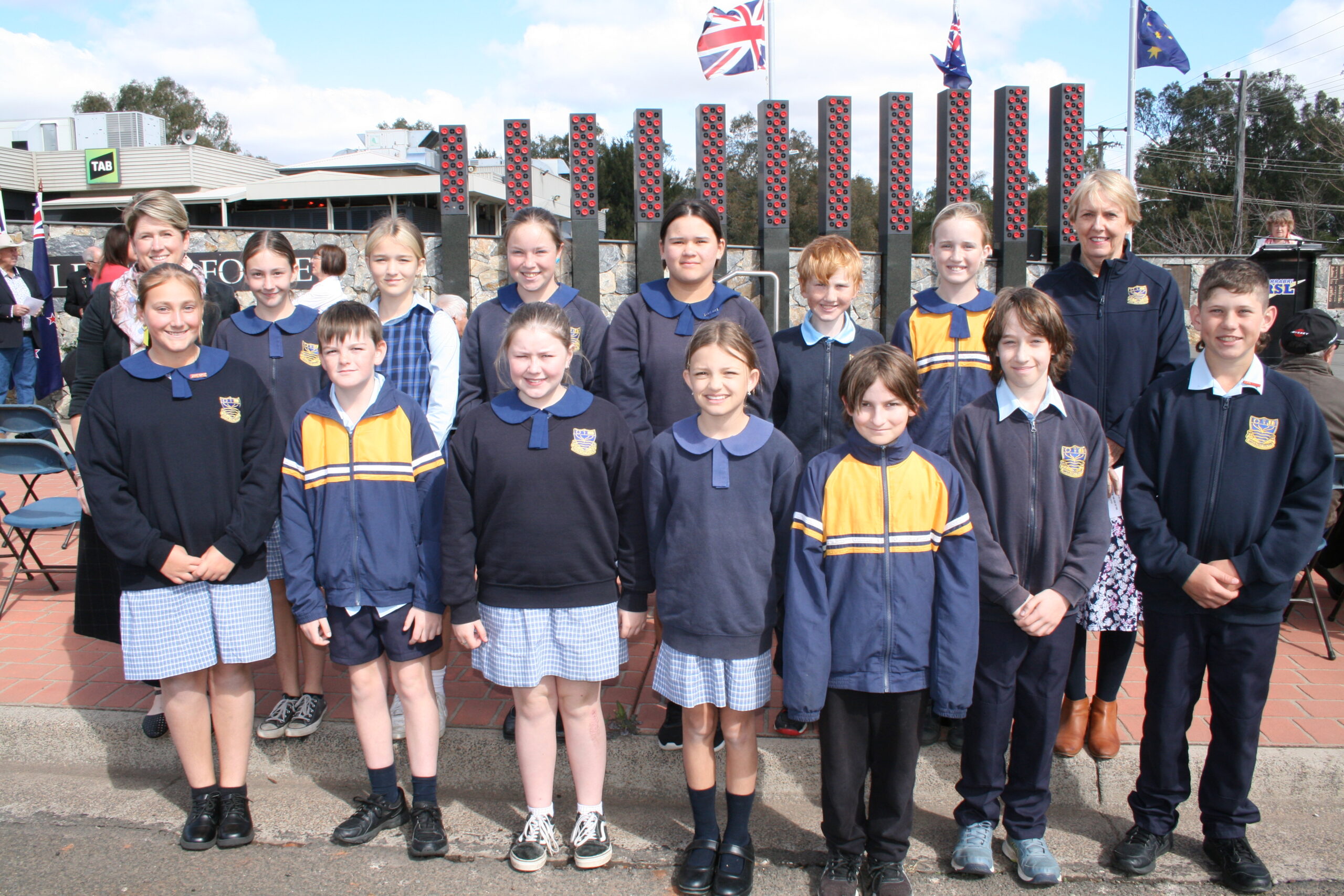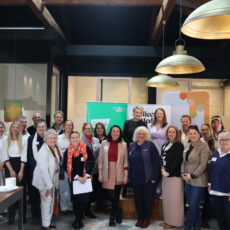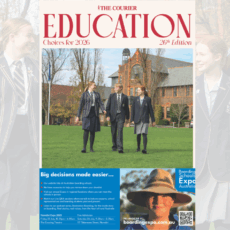Narrabri Public School students Ashlyn Saunders and Lincoln Bourke researched and presented addresses at Victory in the Pacific Day commemoration ceremony at the Narrabri War Memorial on Friday.
Kokoda was pivotal battle in Pacific war
By Ashlyn Saunders
Prior to the start of World War II, Australians realised that if Japan wanted to strike into Southeast Asia (to secure raw materials) they could easily do so while Britain was preoccupied by a European War.
This fear became a reality at the end of 1941.
The advance of Japanese forces shocked the western world. They attacked the US Pacific Fleet at Pearl Harbour in December 1941 and secured the Malay Peninsula with the fall of Singapore by February 1942. They next planned to advance to Port Moresby, which would facilitate the capture of other centres and weaken the Allied line of communication from the United States to Australia.
However, the Battle of the Coral Sea spoiled Japan’s plans to take Port Moresby by a seaward assault so they changed their plans to a military attack over the Owen Stanley Ranges, via the Kokoda Track.
The Kokoda Track stands as an icon for the Australian participation in the Second World War, just as Gallipoli serves the same purpose for the First World War.
The centre piece of this invasion was an attempt to capture Port Moresby via the Kokoda Track.
From Port Moresby the Japanese could, if they desired, launch an invasion of the east coast of mainland Australia. Without it, they could not.
The Kokoda Track marks the course of one of the most important battles for Australia in the Second World War. Between July 21 and November 16, 1942, the Australian Army halted the furthermost southward advance by Japanese forces in Papua New Guinea and then pushed the enemy back across the mountains.
It is one of the most striking places of Australian wartime history that can be visited.
It was along this track, which crossed incredibly rugged and isolated terrain, that the Australian troops repelled the highly trained Japanese invasion force.
Under conditions of extreme hardship Australian soldiers fought the Japanese first to keep them from reaching Port Moresby and then to push them over the Owen Stanley Range.
During the battle, one of the toughest actions of World War II, Papuan and New Guinean men were employed as carriers.
They played a vital role, carrying supplies and evacuating the seriously wounded and sick troops to safety, sometimes under fire.
Their compassion and care of the casualties earned them admiration and respect from the Australians, who dubbed the men the Fuzzy Wuzzy Angels.
The friendship between the people of Australia and Papua New Guinea continues to this day.
The length of the Kokoda Track was not measured in distance but in how many hours it took to traverse.
Soldiers were challenged by steep, treacherous inclines, deep valleys, dense jungles, a debilitating climate and drenching rain that frequently turned the ground into a quagmire.
The story of Kokoda is one of courage, endurance, mateship and sacrifice.
More than 600 Australians died, and more than 1000 were wounded in the four months of fighting in the vicinity of the Kokoda Track.
Casualties due to sickness exceeded 4000.
Those Australians who died on the Track are buried at the Bomana War Cemetery outside Port Moresby.
The trail has become a tourist pilgrimage, especially for Australians, because of its pivotal role in the battle for the Pacific.
War came close to Australia
By Lincoln Bourke
Victory in the Pacific Day marks Japan’s unconditional surrender to the Allies after more than three years of war.
It’s a special time for us to reflect on the important role that Australians played to end the war in the Pacific region.
On August 15, 1945, Japan accepted the Allied Nations’ terms of surrender and Australia’s Prime Minister, Ben Chifley, announced that the war was over.
On VP Day, we remember Australia’s war efforts from 1942 to 1945 in the Pacific region, including in Singapore, Borneo, Malaya, Papua, New Guinea and New Britain. It was a time when people worked hard and cooperated to defend the nation.
The War in the Pacific was the first time in Australia’s history that people felt directly threatened by an external aggressor. The Royal Australian Navy, Australian Army, and Royal Australian Air Force were engaged in areas including Malaya, Singapore, Timor, Milne Bay, New Guinea, Borneo, Bougainville, Guadalcanal, and the Coral Sea.
We commemorate those who served in the war. Some 40,000 Australians didn’t return home to their families. Over 17,000 of them lost their lives while fighting in the war against Japan, some 8000 of whom died in Japanese captivity.
There were two major places where World War II took place. These places are sometimes called theatres of war. One theatre of World War II was in Europe, the other was in the Pacific.
The Pacific theatre of war included Japan, China, Korea, the Philippines, and many more islands and countries in Southeast Asia.
Japan wanted to become a strong country and a world leader. However, because Japan was a small island country, they had to import many natural resources. Some Japanese leaders felt they needed to gain more land by conquering other countries.
Although the US was trying to avoid getting involved in World War II, Japan was worried that the US would try and stop them from taking over some countries in Southeast Asia. They decided to attack the US Navy hoping they could sink enough ships to keep the US from ever attacking Japan.
On December 7, 1941 Japan attacked the US Navy at Pearl Harbor in Hawaii. They surprised the US and sunk many ships. However, this attack did not have the effect the Japanese had hoped.
The Japanese quickly took over much of Southeast Asia and were well on their way to dominance by 1942. However, the US won a critical battle called the Battle of Midway on June 4, 1942. Badly outnumbered, the US Navy sunk four Japanese aircraft carriers and forced the Japanese to retreat. Winning this battle gave the Americans cause for hope and was a turning point in the war in the Pacific.
After the Battle of Midway the United States began to fight back against the Japanese. The gallant efforts of the Australian troops in Papua New Guinea prevented the Japanese from coming closer to Australia.
Finally in 1945 the Japanese army had been pushed back to Japan.
However, the Japanese would not surrender. Instead of invading, President Harry S. Truman decided to use a new weapon called the atomic bomb. The first atomic bomb was dropped on Hiroshima, Japan on August 6, 1945. It completely destroyed the city and killed thousands and thousands of people. Japan did not surrender. Another atomic bomb was dropped on Nagasaki, Japan. This time the Japanese decided to surrender.
The experiences of Australian servicemen and servicewomen varied greatly.
Some endured tough conditions on the Kokoda trail, while others came under attack at sea. Special Forces undertook reconnaissance and sabotage operations, and many Australians became prisoners of the Japanese.
We are standing here today as a result of our brave and heroic service men and women who protected our nation when called upon to do so.
To order photos from this page click here











